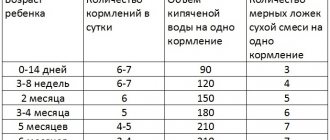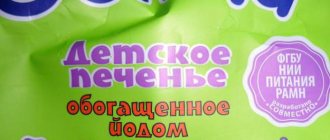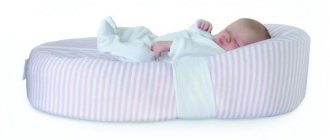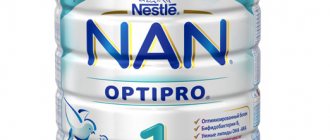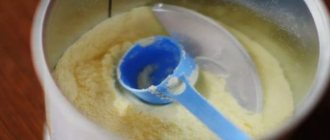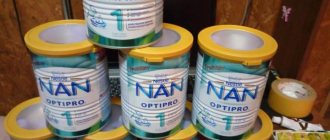For full growth and development, a child, especially an infant, needs a balanced diet. Diet has an impact on both physical and intellectual development. Natural breast milk contains a full range of vitamins, minerals, and beneficial elements. That is why every young mother should strive to prolong natural feeding as much as possible.
It is far from uncommon to have a forced transition to artificial feeding; the selection of a formula - a substitute for mother's milk - is a responsible, important stage. The selected product should closely match the composition and properties of breast milk. The “Nestozhen” mixture is widely popular on the domestic market. The main criterion when choosing a formula is how the child reacts to the product.
Reasons for bottle feeding
Breast milk substitutes, for example, the “Nestozhen 1” formula, are, under certain circumstances, a good, but not equivalent, replacement for breastfeeding. Experts strongly recommend breastfeeding for at least one year.
It is necessary to introduce an artificial product into a baby’s diet only if it is justified from a medical point of view.
It is impossible to carry out natural feeding as necessary:
- dangerous pathologies in a nursing woman, along with the use of medications that are incompatible with breastfeeding;
- the inability of the baby’s body to break down milk sugar;
- insufficient amount or complete absence of breast milk;
- the need for a young mother to go to work;
- taking antibiotics;
- pathogenic bacteria found in breast milk;
- mental pathologies.
Situations for introducing formula, for reasons related to the child:
- pathologies associated with metabolism;
- sleep disturbance, frequent breastfeeding;
- refusal or sluggish sucking of the mother's breast;
- abdominal pain, frequent regurgitation of mother's milk.
The above cases are objective reasons for switching to artificial feeding.
There are also cases when a woman avoids breastfeeding in order to maintain “good shape.” Such “irresponsible” mothers must realize that no amount, even the best artificial nutrition, will ever replace the unique mother’s milk.
Important! Think seven times before depriving your baby of mother's milk, vital for his full growth and development, because of selfish, temporary bonuses. The introduction of artificial formulas into a child’s diet should be carried out after consultation with a pediatrician; he will help to correctly assess the need for this measure and determine the appropriate product.
Advantages and disadvantages
Breastfeeding substitutes, although they differ significantly, have a number of advantages over maternal feeding:
- frees up free time, which is of great importance for a young mother with a lot of worries; the mother can even leave home, because Any family member can feed the baby;
- increased control over the child’s diet - the mother clearly knows what portion she is giving; if an allergy occurs, it is enough to change the formula; with natural feeding, we are talking about a complete change in the diet of the nursing mother.
The most significant disadvantage of artificial feeding is that the baby is more susceptible to various diseases and allergic reactions. The immune system of such a child is deprived of the natural protection that he receives from breastfeeding.
If artificial feeding is an inevitable necessity, the young mother must carefully approach the choice of formula, study the rules for its storage and preparation.
Adapted Nestozhen mixtures have the following advantages:
- used for infants from the moment of birth;
- provide good sleep for the baby;
- a developed network of suppliers - can be purchased in almost any store;
- affordable price;
- nice smell;
- promotes the normal functioning of the baby’s digestive system;
- a complex of vitamins and minerals ensures the normal functioning of the main organs of the child’s body;
- The quality of the brand's products meets European standards.
The disadvantages of Nestozhen mixtures include:
- It is not recommended for use by children susceptible to allergic reactions; in them the product can lead to unpredictable consequences;
- according to consumers, the product has an uncomfortable soft bag inside the package;
- strong sweet taste;
- long period of dissolution of the mixture upon contact with water.
Young mothers, when forced to decide on artificial feeding, should pay attention to high-quality, time-tested products; it is necessary to study the opinions of pediatricians and consumers.
Choosing products from the Swiss company Nestle under the Nestozhen brand will not only feed your baby, but also strengthen his health and immunity.
Baby formula "Nestozhen" includes a complex of essential vitamins, minerals, and beneficial elements:
- whey protein, which is well accepted by the child’s body;
- prebiotics, which help normalize digestion and normal intestinal functioning;
- contains a lot of maltodextrin - molasses with a sweet taste.
Experts say that the high content of maltodextrin in baby food is a negative aspect. The “Nestozhen” mixture, the composition of which does not include the presence of DHA and ARA, which is a negative factor, since these elements are involved in the formation of the organs of vision and hearing.
Kinds
It is impossible to find a complete replacement for breast milk.
Nevertheless, the composition of most modern brands on the milk formula market contain identical components: vitamins and minerals, proteins, carbohydrates, fats. Products that are most similar to breast milk are called adapted.
Mixtures with medicinal properties are recommended for children with pathologies of the digestive system. These mixtures eliminate allergic reactions, lactose intolerance, colic, and constipation.
The product, called “night mixture,” includes emollient biological substances and hormones. When choosing one or another mixture, you must seek advice from a pediatrician who knows the specifics of the body of a particular child.
The Swiss company produces the following types of infant formula under the Nestozhen brand:
"Nestogen 1"
The adapted dairy product “Nestozhen 1” is intended for infants from birth to six months. Composition of the mixture: in addition to a complex of vitamins and useful elements, it also contains iron and iodine - substances necessary for the normal functioning of the brain and central nervous system. Zinc and selenium help improve immunity, calcium is good for teeth and bone tissue.
Unstable 1 mixture composition table of components is given below:
- Age group: infants from birth to six months of age.
- Weight: 350; 700 grams.
- Use: in case of complete absence or lack of breast milk.
- Components: the product contains protein components, the most important vitamins and minerals that contribute to the normal development of the baby’s body. Natural prebiotics (GOS, FOS) normalize stool and promote normal digestion. Lactobacilli promote the development of the digestive organs, the formation of normal microflora of the mucous membranes of the digestive organs, and eliminate various pathologies of the digestive system.
- Price: 320; 577 rubles respectively.
"Nestogen 2"
The breast milk substitute "Nestozhen 2" is aimed at children from six months to one year of age. This product can be dairy, or with various components, for example, rice flour. Natural fibers normalize digestion.
Fatty acids, a complex of vitamins and minerals contribute to the optimal growth and development of the child. The product's properties are as close as possible to breast milk; its balanced composition ensures good digestion.
- Age group: nutrition for children aged six months to one year.
- Weight: 350; 700 grams.
- Use: dairy product, when introducing complementary foods or as an additive to the main diet.
- Ingredients: Natural prebiotics (GOS, FOS), stabilize stool, improve digestion. The product contains fats, a complex of vitamins and minerals, beneficial elements (iodine, iron), they contribute to the normal functioning of the brain. Zinc and selenium act as antioxidants. Calcium promotes the normal development of bone tissue and teeth.
- Price: 320; 577 rubles respectively.
You might be interested in:
Nanny's mixtures are a unique composition for the best development of the baby!
Selecting Bellakt mixture for a child
Composition, types and characteristics – Nutrilak mixtures
The best domestic baby formula “Istrinsky” for newborns
"Nestogen 3"
The adaptive breast milk substitute "Nestozhen 3" is intended for feeding children aged 10 to 18 months.
The product is diluted in boiled water, the mixture contains a complex of the most important vitamins and minerals.
- Age group: for feeding children without pathologies from 10 months to one and a half years.
- Weight: 350; 700 grams.
- Use: dairy product - a substitute for cow's milk, when introducing complementary foods or as an additive to the main diet.
- Components: a complex of natural prebiotics “Prebio”, which promote normal digestion and normalization of stool. Lactobacilli contribute to the normal development of the digestive system and form healthy microflora. Does not contain GMOs, preservatives, dyes, flavors or other harmful additives.
- Price: 328; 563 rubles respectively.
"Nestogen 4"
The mixture "Nestozhen 4" is used to feed babies over one and a half years old. Experts insist on using this product when practicing hygiene skills, as well as when toilet training a child.
- Age group: for babies aged from one and a half to two years.
- Weight: 350; 700 grams.
- Use: comprehensive nutrition for children.
- Components: a complex of natural prebiotics “Prebio”, which promote normal digestion and normalization of stool. Contains fats, a complex of vitamins and minerals that contribute to the normal development of all systems of the child’s body. Experts recommend using it for easier development of hygiene skills (toilet training).
- Price: 340; 606 rubles respectively.
"Nestogen" low lactose
Adaptive dairy product containing prebiotics. A small amount of lactose helps restore balance in case of lactose deficiency. Good absorption of the mixture by the body is ensured by its low osmolarity.
Nucleotides help restore the balance of the digestive system after diarrhea. Does not contain GMOs, preservatives, dyes, flavors or other harmful additives.
- Age group: for infants from birth.
- Weight: 350 grams.
- Use: complementary feeding for children who do not have developmental pathologies, basic nutrition for lactose deficiency or diarrhea.
- Components: the product contains protein components, the most important vitamins and minerals that contribute to the normal development of the baby’s body. Natural prebiotics (GOS, FOS) normalize stool and promote normal digestion. Lactobacilli promote the development of the digestive organs, the formation of normal microflora of the mucous membranes of the digestive organs, and eliminate various pathologies of the digestive system.
- Price: 354 rubles.
"Nestogen 2+. Happy dreams"
Infant formula “Nestozhen 2+. Happy dreams" with prebiotics, rice flour. The raw material is whey powder. The product's properties are as close as possible to breast milk; its balanced composition ensures good digestion.
The mixture contains natural prebiotics, has greater density and calorie content due to the use of rice flour, and a complex of vitamins and minerals.
- Age group: 6 to 12 months.
- Weight: 350 grams.
- Use: for feeding children who do not have pathologies, when introducing complementary foods, or as an addition to the baby’s nutritious diet.
- Components: “Prebio” complex (GOS – 90%, FOS – 10%), the protein in the product in composition and properties is as close as possible to breast milk. The complex of vitamins and minerals provides the baby’s body with all the necessary substances for the normal development of all body systems. Complex carbohydrates and special protein amino acids have a positive effect on sleep time by reducing the number of meals.
- Price: 180 rubles.
"Nestozhen Low Lactose"
For children from birth to one year with secondary lactase deficiency (decreased activity of the lactase enzyme that breaks down lactose), “Nestozhen Low Lactose” is produced. It belongs to specialized nutrition and can only be prescribed by a pediatrician. Low-lactose formulas are usually indicated for bottle-fed children, since complete exclusion of lactose from a newborn’s diet threatens the development of dysbacteriosis and disruption of the formation of the nervous system. It is impossible to say in advance whether the product is suitable for your child, since it all depends on the degree of lactase reduction in the body. It is possible that this concentration of lactose will be too high and after several days of use you will have to change your diet again. Since the lactose content in the product is reduced, glucose syrup gives it a sweet taste. A distinctive feature of this brand is the addition of nucleotides, which are needed to restore the intestinal walls after diarrhea.
How to properly introduce and prepare?
When choosing a mixture, the most correct decision is consultation with an appropriate specialist. If you have doubts about the required qualification level of a specialist, you need to listen to his recommendations, since he deals with a large number of children and has the most reliable information on the issue.
When choosing a breast milk substitute yourself, you need to pay special attention to the following points:
- Adaptability of the product - for newborn babies up to six months of age, the famous pediatrician Komarovsky advises feeding with highly adaptive substitutes, since their composition is closest to breast milk. They are distinguished by their high cost, but the dosage during this period of the child’s development is insignificant. For feeding babies aged 6 to 12 months, it is recommended to use more affordable, medium-low adaptive formulas.
- Product suits the baby's age group. It is forbidden to give to a child aged 3 months, the product is aimed at six-month-old and one-year-old babies, this can greatly harm the baby’s health.
- Taking into account the special properties of mixtures. There are many products aimed at babies with various characteristics - allergic reactions, anemia, refusal to accept mother's milk or cow's milk. Mother's milk substitutes containing probiotic bacteria are well suited for babies of any age; they improve digestion and stimulate the child's immune system.
- Availability of a wide network of sellers of products of a particular brand. When buying formula is a whole adventure, it creates additional stress, both for the baby and for his parents. Give preference to an affordable product.
When it is impossible to do without artificial feeding, you need to correctly introduce complementary foods in order to avoid stress for the child’s developing child’s body, the algorithm is as follows:
- When the baby is still hungry and the mother’s breast is without milk, you need to prepare and give the baby about 20 milliliters of the mother’s milk substitute “Nestozhen 1”; the procedure must be repeated for subsequent feedings.
- In the following days, the baby is offered a full dose of breast milk substitute; the next time, natural feeding is replaced by half.
- If negative reactions to the formula appear at the beginning of artificial feeding, drastic actions should not be taken; it is necessary to give the baby’s body the opportunity to adapt to the new diet. In case of a prolonged reaction lasting more than 5 days, the diet must be changed after consulting a specialist in advance.
Such a gradual introduction of complementary foods will ensure the baby's interest in the formula and the transition to it without stress.
There are a number of products that improve lactation for young mothers who are breastfeeding:
- halva;
- dill decoction;
- rose hip;
- ginger;
- Melissa;
- watermelon;
- dried fruits;
- fish;
- nuts.
Proper dilution of a breast milk substitute involves following the recommendations outlined in the instructions provided by the manufacturer. The product insert contains information on the dosage and methods of preparing the “Nestozhen 1” mixture.
Cooking algorithm:
- Before you start diluting the mixture, you must wash your hands well with detergent.
- Clean the container (nipple with cap, bottle) from traces of previous use.
- Pasteurize the container for 5 minutes, isolate from outside influences.
- Bring regular water to a boil, then cool it to 37 degrees.
- Using the measuring chart located in the insert, pour the required amount of chilled water into the container.
- Before using the special spoon that comes with the product, you need to wash it well and dry it. When diluting the mixture, you must use only a special spoon, and you must scoop up the product without a mound.
- Using the measuring table, determine and add the required number of special spoons of powder, the norm should correspond to the baby’s age group.
- Bring the resulting solution to a homogeneous state, preferably without lumps.
- After opening the package with the mixture, you must carefully ensure that it is closed and isolated from various influences.
When preparing, we use a special spoon, strictly without a heap. Increasing or decreasing the dosage may cause dehydration of the baby’s body, or disruption of the diet. The process of diluting a breast milk substitute is simple, accessible to any family member.
How to give baby formula Nestozhen
To introduce the Nestogen mixture, you need to familiarize yourself with some rules for using this product.
- It is not recommended to give this porridge to children 3-4 months old. It is designed for children from 6 months.
- Give preference to breastfeeding. However, if the young mother does not have milk, you can use Nestozhen infant formula.
- Before cooking, wash your hands and utensils thoroughly.
- It is better to sterilize the containers in which you plan to prepare food for about 5 minutes.
- Boiled water is cooled to 37 degrees and poured into containers in accordance with the recipe written on the pack. Using a special measuring spoon, add the required amount of dry powder to the water.
- Shake the container to obtain a homogeneous mass.
- It is better to start getting acquainted with a new dish with 20 grams of the ready-made mixture. The next day you can replace the whole thing by feeding porridge. In the future, feel free to replace half of your daily diet with this baby product.
- If you notice negative reactions in your child’s body after taking baby food, do not rush to stop complementary feeding. Allow the baby's stomach to adapt to the new dish for about 5 days. If the symptoms recur, you should contact your pediatrician to prescribe a new suitable complementary food for your child.
- After opening a package of porridge, it is important to ensure that no moisture gets in.
FAQ
Sometimes the inexperience of young mothers leads to the fact that they are faced with simple questions, but do not know how to solve them. Let's look at the most important points regarding breast milk substitutes and baby feeding.
Experts recommend feeding your baby according to certain rules:
- the baby should be positioned half vertically - this position is practical when sucking, which also eliminates the possibility that the child will choke on the mixture;
- in order to avoid digestive problems, it is necessary to control the level of milk in the bottle - it must completely cover the nipple, air can only be at the bottom of the bottle;
- After eating, the baby needs to stay in a vertical position for some time; you can put his head on your shoulder. This procedure allows you to remove excess air from the stomach cavity;
- if the baby refuses to eat food through a bottle, or eat from a spoon. The mixture must be introduced into the baby’s body using a syringe (after removing the needle), the main thing is to do this as slowly as possible, in small portions.
Let's look at the main points regarding handling the mixture:
- The use of raw water or unpasteurized containers, violation of the rules of breeding, preservation, transportation, and feeding can cause complications in the child’s health.
- The mixture must be prepared before the child eats.
- It is important to strictly follow the instructions from the manufacturer; the proportions given in the instructions cannot be changed without the advice of a specialist.
- If residues of the prepared mixture form, its storage and further use for feeding the baby is strictly prohibited.
- Directly when feeding the baby, you need to support it to avoid choking. As the baby grows up, it is necessary to switch to food from more convenient containers, for example, a cup.
- In order to preserve beneficial elements, bacteria, vitamins and minerals that are important for the child’s body, boiled water must be brought to body temperature before diluting the mixture.
- If diarrhea occurs, consult a specialist; this pathological condition quickly dehydrates the baby’s body and can cause significant damage to the baby’s health.
- After 6 months, if possible, it is necessary to dilute the child’s diet with cereals, vegetables, fruits, meat, and fish. In this case, this must be done after consultation with a specialist, which will allow taking into account the individual characteristics of the baby. With the recommendation of a specialist, and the earlier introduction of new products into the baby’s diet, the dosage of the mixture must be reduced.
- Before and after opening the container with the product, it must be stored at a temperature of no more than 25 degrees, with air humidity up to 75%. The package of the mixture must be completely consumed within 21 days, and the product should not be stored in the refrigerator.
What is better “Nestozhen” or “NAS”?
Breast milk substitutes under the Nestozhen and NAN brands must be compared according to the most important parameters: product composition, product safety for the baby, ease of use, consumer reviews.
High-quality mixtures contain prebiotics and probiotics; these substances contribute to the formation of normal intestinal microflora and improvement of digestive processes. They also prevent the occurrence of allergic reactions, the development of infectious pathologies, and increase the immunity of the baby. Good metabolism will be ensured by fats and nucleotides.
"Nestozhen" or "NAS"? Let's consider each of the products from the point of view of the most important criteria, positive and negative aspects. Both products are produced by Swiss.
The positive aspects of “Nestozhen” include:
- practical packaging;
- low cost and wide network of suppliers;
- low osmolality;
- does not contain palm oil;
- contains probiotics;
- contains prebiotics GOS and FOS;
- calcium and phosphorus in optimal quantities;
- mixtures "Nestozhen 1,2" contain a higher amount of whey proteins compared to casein.
Among the negative aspects of breast milk substitutes under the Nestozhen brand are the following:
- the brand line contains only one specialized product - “Nestozhen Low Lactose”;
- The product does not contain DHA and ARA acids;
- mixtures "Nestozhen 1,2,3,4" do not contain nucleotides;
- the presence of only one amino acid - taurine.
The positive aspects of mixtures under the NAN brand are:
- the product “NAN 1” has a unique protein composition, the ratio of whey and casein proteins is closest to breast milk;
- mixtures “NAN 1,2,3,4” do not contain palm oil;
- the product includes the most essential fats, nucleotides, prebiotics, amino acids, a complex of vitamins and minerals.
Among the negative aspects of NAN mixtures are the following:
- increased lactose content, which negatively affects the digestion process, especially with lactase deficiency;
- increased osmolality of the product, which additionally loads the baby’s excretory systems;
- The mixtures do not contain prebiotics.
There is no direct advertising in the article - independently evaluate the pros and cons of these brands and choose the most suitable solution specifically for your baby. If in doubt, consult your pediatrician!
How to understand that the mixture is not suitable?
When feeding babies artificially or mixedly, a breast milk substitute is often the main, and maybe the only, source of useful elements and nutrients. How well the child develops directly depends on the quality of absorption and the components of the mixture.
Vigilance regarding whether the choice of product is correct can only be beneficial on the part of attentive parents. It is necessary to remember the signs that are a compelling argument for consulting a specialist.
Urgent measures are needed if:
- after consuming the mixture, the child becomes restless, often cries, and difficulties arise when trying to return the baby to a normal state;
- the occurrence of redness and rashes on the baby’s skin;
- frequent regurgitation - during feeding, in between meals;
- abnormalities in the functioning of the digestive system - bloating, accumulation of gases, rare stools with inclusions of lumps of food;
- Poor weight gain by the child.
Is there any harm from using Nestozhen?
All the variety of breast milk substitutes are made from high-quality raw materials, similar in composition and properties to breast milk.
Drinking breast milk is not harmful, which unfortunately cannot be attributed to artificial nutrition:
- if the container for the prepared solution is poorly cleaned, as well as in case of violation of the rules for preparing a mother's milk substitute, the emergence and active development of pathogenic microorganisms may occur, which can cause severe poisoning of the baby, even leading to death;
- Mother's milk is absorbed by the baby's body 100%, which cannot be said about formulas. Thus, the iron included in the product is not fully absorbed, which can cause the development of iron deficiency anemia;
- with artificial feeding, the workload of the liver, stomach, and kidneys increases up to three times;
- when palm oil is added to the product, the mineralization of bone tissue deteriorates;
- the likelihood of developing caries, obesity, diabetes, vision impairment, and malocclusion increases by approximately 2 times.
Milk formulas for healthy children
All Nestozhen products for healthy children under one year of age are breast milk substitutes, which, depending on age, are divided into:
- infant formula "Nestozhen"1 and "Nestozhen"1 Midi from birth to six months;
- infant formula "Nestozhen"2 and "Nestozhen"2 Midi from six to twelve months.
The only difference between Midi is the economical packaging format, where the dry product contains not 350 g, but as much as 700 g. There are no differences in composition. As for “Nestozhen” 3.4, they differ significantly from breast milk, therefore they are not a substitute for it and are called baby milk, divided into:
- Baby milk "Nestozhen" 3 from twelve months;
- Baby milk "Nestozhen" 4 from eighteen months.
The company’s successful development is packaging, which, after opening, reliably protects the contents from external influences due to the box with a lid and a convenient spoon-clip for the package.
Dairy components of baby food are made from milk from Swiss farms approved by Nestle specialists, which serves as a guarantee of their quality. “Nestozhen”, like breast milk, has a low osmolality, due to which it does not place an increased burden on the baby’s excretory system.
Read more about the composition and properties of breast milk in this article.
Squirrels
The protein component of “Nestozhen”1,2 consists of 60% whey proteins, as in mature breast milk of a woman. In Nestozhen3,4 whey protein makes up only 23% of the total protein content. Cow's milk differs in amino acid composition from human milk protein, so manufacturers of human milk substitutes often add additional missing essential amino acids to the composition. Unfortunately, this brand of baby food contains only one essential amino acid – taurine.
Important! “Nestozhen” breast milk substitutes do not contain hydrolyzed protein and are not hypoallergenic, so they can cause an allergy to cow’s milk protein.
Carbohydrates
In addition to milk sugar - lactose, it contains maltodextrin, which makes ready-made baby food thicker and provides a long-lasting feeling of fullness. “Nestozhen” 3.4 do not contain sucrose, which distinguishes them favorably from some similar products from other manufacturers.
Fats
The fatty component is represented by a set of vegetable oils that provide the body with fatty acids. Palm oil is not among them. Baby food does not contain docosahexaenoic (DHA) and arachidonic (ARA) acids, the source of which in other baby foods is fish oil, which is an obvious disadvantage, since these acids help strengthen the immune system and are necessary for the proper development of vision and the brain.
Read more about other types of palm oil-free baby food in this article.
Other components
Baby food contains natural prebiotics Prebio (galactooligosaccharides (GOS) and fructooligosaccharides (FOS)), which stimulate the growth of beneficial intestinal microflora - bifidobacteria and lactobacilli. As a result of their activity, a low pH in the intestine is achieved, unfavorable for the development of pathogenic microflora, and short-chain fatty acids are synthesized, as in breastfed children. Short-chain fatty acids ensure the normal condition of the intestinal epithelium, its energy supply, and contribute to its antibacterial and antiviral protection. The decrease in pH stimulates intestinal motility, and fatty acids and dietary fiber retain sufficient fluid in the large intestine, which promotes the formation of soft stools. Thus, the introduction of GOS and FOS helps prevent constipation.
The optimal ratio of calcium and phosphorus promotes the formation of soft stools and reduces the risk of constipation. The addition of probiotics - lactobacilli L.reuteri promotes the maturation of the gastrointestinal tract, normalizes the microflora and reduces the feeling of discomfort.
Find out prices for "Nestozhen" in the online store Obstetrics
Photo "Nestozhen"1 and instructions for use
Nestozhen
“Nestozhen 1” instructions
